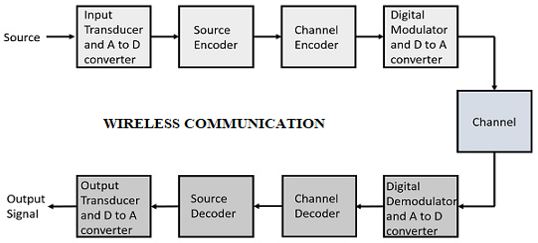Wireless Communication is basically the technology where electromagnetic radio waves can be transmitted from one point to another. It eliminates the need of devices being connected with any physical medium like wires, cables or optical fibres as in case of Wired communication.
With the wireless communication technology information can be passed on to a distant radio receiver easily and hence this technology can achieve long distance communication. Today, we have many wireless communication systems in place like mobile phones, Bluetooth audio, Global Positioning System, Wi–Fi, etc.
One of the most booming industry which has its backbone relying totally on Wireless Communication technology is the Internet of Things or IoT. IoT is a broad area of interconnected computing devices which can transfer information to one another in a network.
It is clearly understood that in order to have a larger expanse of network, we must opt for Wireless Communication technology. Though speed may be a concern in Wireless Communication, but with the boom of cloud technology speed of the data transfer in IoT network is becoming at par with that of the Wired Communication technology, for e.g. Ethernet.
History of Wireless Communication
Pre historic people used sign languages, smoke signals or flashing mirrors for long range communication without the use of any physical medium i.e. “wireless”. Since then this type of communication is continuously evolving. Now electric signals and radio waves are used for wireless communication.
In 1897 Marconi was the first to detect radio waves and use them in Wireless Telegraphy. Since then a rapid growth of wireless technology has been witnessed which have replaced many wired systems like conventional Telephone communication and Television transmission.
Advantages of Wireless Communication
♦ Cost – Installation charges and hassles of handling bulky wires and cables can be eliminated.
♦ Mobility – It is one of the biggest advantages of wireless communication which allows a device to be connected and still allowing the freedom to move.
♦ Reliability – Any communication failure due to breaking of wires or damage to these cables due to environmental conditions is completely eliminated. In case of any natural disaster the damage to wireless infrastructure is minimum.
Working of a Wireless Communication
The system basically consists of three elements – Transmitter, Channel and Receiver.

• The Input Transducer – It takes the physical input signal and converts it into an electrical signal. An Analog to Digital Converter or A/D converter converts this analog signal to digital sequences for further processing.
• Source Encoder – This element removes any redundant bits and passes only required information to make effective use of the bandwidth.
• Channel Encoder – The channel encoder encodes the signal with some data correction bits like start /stop bits or parity bits to protect the signal from noise due to the external factors.
• Digital Modulator – The signal is modulated by a high frequency carrier so that it can travel in the medium. It can use Amplitude modulation, Frequency modulation and Phase modulation.
• Channel – Channel can be any physical medium where signal can be transmitted to the receiver end.
• Digital demodulator – At the receiver end the first step is to demodulate the received signal and is converted again from analog to digital format.
• Channel Decoder – It does the error correction to eliminate the noise at the receiver end. This helps to recover the original signal back.
• Source Decoder – Here the signal is again digitised by sampling and quantizing so that we get error- free information.
• Output transducer – It brings back the original signal as it was given input to the input transducer. And hence the transmission of the physical signal is completed safely to reach at the receiver end.
Key Points to remember while designing wireless solution for IoT
• Target price – Choose a wireless solution which will optimally solve the requirement of IoT application while maintaining the final end cost to the customer.
• Wireless connectivity and range – Choose from the various options available for wireless technology which can suffice the range of transmission and connectivity for the required IoT network.
• Geographic location – Depending upon where the final end product is going to be installed, various design decisions, go-to-market strategies are defined.
• Use case of the product – Depending upon the application of the product like how much data the network should process and transmit, how fast it should process the data are the key factors for choosing the wireless technology.
Author
Anupama kumari
M.Tech (VLSI Design and Embedded system)
BS Abdur Rahman University
